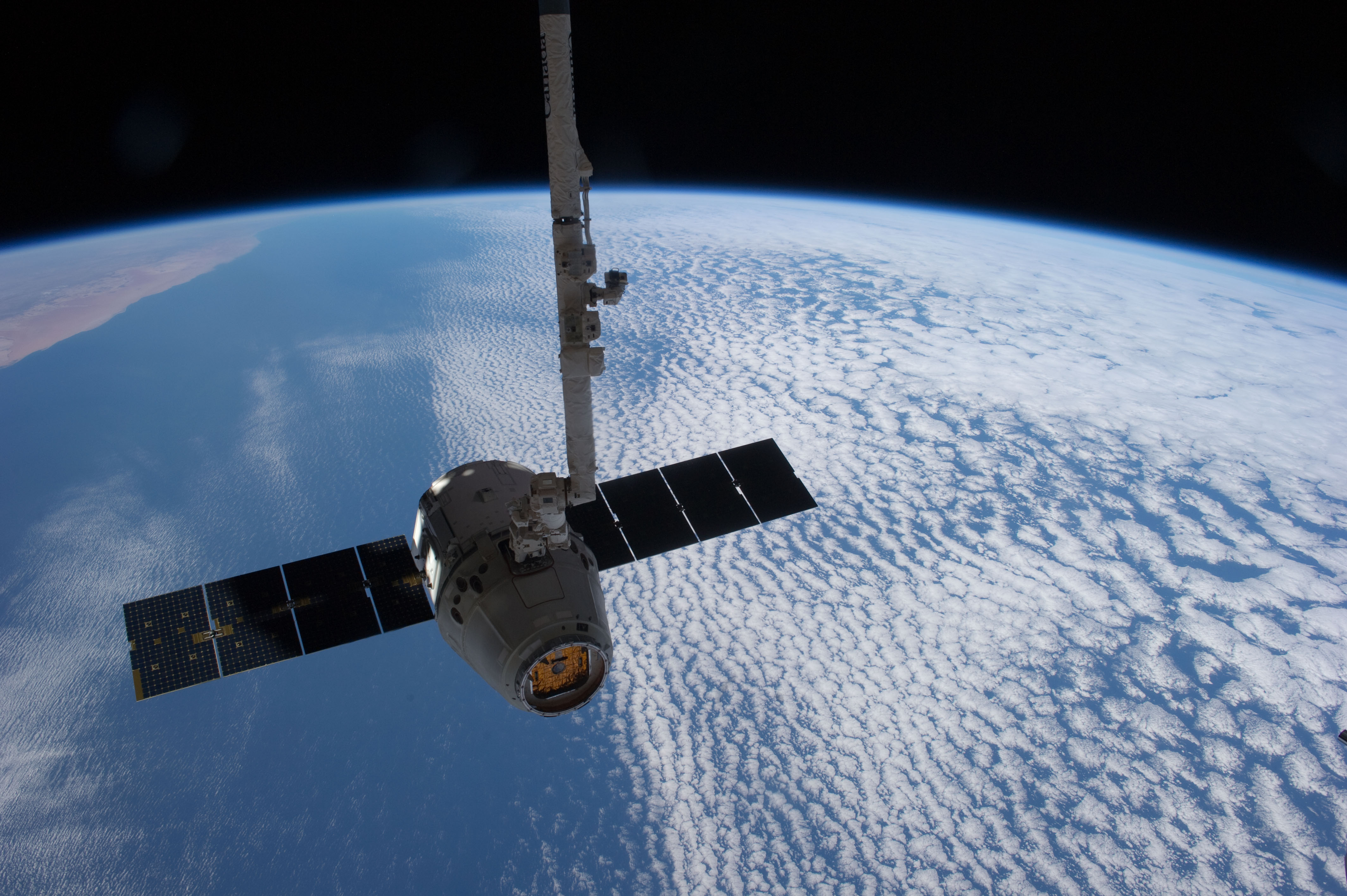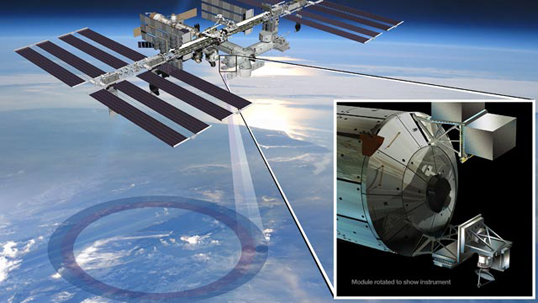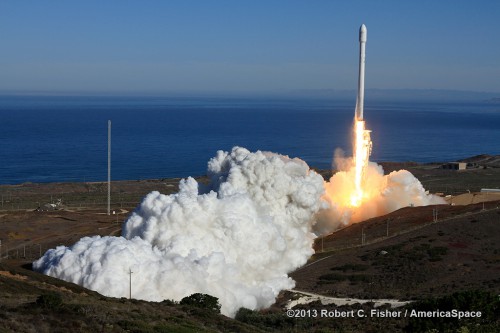
More than two years since the last shuttle mission, the transition from construction to utilization of the International Space Station (ISS) has occurred and the orbital complex is steadily spreading its wings as an operational platform for science. Yesterday (Tuesday, 29 October), NASA announced plans to launch its $26 million Rapid Scatterometer—or “RapidScat”—aboard one of SpaceX’s Dragon cargo vehicles in 2014. After arrival at the ISS, RapidScat will be removed from Dragon’s unpressurized “trunk” by the station’s robotic assets and installed onto the European Columbus module. It marks one of several key scientific and engineering payloads assigned to ride aboard SpaceX’s workhorse cargo ship, which has flown two of a scheduled 12 Commercial Resupply Services (CRS) missions in October 2012 and March 2013, as part of its $1.6 billion contract with NASA.
Using low-energy microwave emissions, RapidScat will monitor the velocity and direction of oceanic winds and is expected to yield valuable data to complement three other operational satellite “scatterometers.” Europe’s MetOp-A and B missions, launched in October 2006 and September 2012, together with India’s OceanSat-2, which rose to orbit in September 2009, have already made significant inroads into an international effort to understand the ways in which interaction between the oceans and the atmosphere influence our planet’s climate. Once operational, the location of RapidScat aboard the ISS—which occupies a high-inclination orbit of about 51.6 degrees—is expected to regularly cross the orbital tracks of its three satellite sisters, thereby offering a critical calibration source.
The urgent need for such a mission has become particularly acute in the last few years. Back in June 1978, NASA launched its short-lived Seasat mission, which offered great insights into oceanic behavior from a space-based instrument, and in June 1999 the agency lofted its Quick Scatterometer (QuikScat) spacecraft. The latter included a scatterometer called “SeaWinds,” whose 3.3-foot (1-meter) rotating antenna functioned for more than a decade, until it suffered a bearing failure on its motor in November 2009. This significantly impaired its ability to perform ocean wind measurements.

Last year, NASA announced its intention to launch a replacement instrument, assembled from spare parts left over from the development of QuikScat and the Advanced Earth Observing Satellite (ADEOS)-II, a joint U.S., Japanese, and French mission, launched in December 2002. “The ability for NASA to quickly reuse this hardware and launch it to the space station is a great example of a low-cost approach that will have high benefits to science and life here on Earth,” said ISS Program Manager Mike Suffredini. His praise was echoed by RapidScat Project Manager Howard Eisen: “RapidScat represents a low cost approach to acquiring valuable wind vector data for improving global monitoring of hurricanes and other high intensity storms. By leveraging the capabilities of the International Space Station and recycling left over hardware, we will acquire good science data at a fraction of the investment needed to launch a new satellite.”
Remarkably, RapidScat rose from planning to reality in barely 18 months, with Suffredini having offered Eisen’s team a mounting location on the Columbus module and a “free ride” aboard a Dragon cargo flight. “This accelerated timeline,” noted a NASA news release, “is a blink of an eye for NASA, where the typical project is years or decades in the making.” Much of the progress is attributable to the instrument’s use of commercial, off-the-shelf computer hardware, but has met with difficulties, not least the procurement of connectors which will enable RapidScat to physically attach itself to the ISS. “They’re special robotically-mated connectors that haven’t been made in years,” Eisen said. “We’re having to convince the company that produces these connectors to make us a small run in time for the mission and it hasn’t been easy.”
With MetOp-A and B and OceanSat-2 operating in polar orbits, the course of the space station’s 51.6-degree orbit will carry RapidScat over Earth’s surface at constantly changing times of day. Since oceanic winds are greatly affected by solar radiation—which also varies with the time of day—trends which currently escape the notice of the European and Indian scatterometers should be detectable by RapidScat. “We’ll be able to see how wind speed changes with the time of day,” said Project Scientist Ernesto Rodríguez. “RapidScat will link together all previous and current scatterometer missions, providing us with a more complete picture of how ocean winds change. Combined with data from the European ASCAT scatterometer mission, we’ll be able to observe 90 percent of Earth’s surface at least once a day, and in many places, several times a day.” According to NASASpaceflight.com, RapidScat’s arrival at the ISS (together with its adaptor bracket) will occur on SpaceX’s fourth CRS cargo resupply mission—designated “SpX-4″—and is presently scheduled for launch on 29 April 2014.

Next year promises to be an exciting one for the Hawthorne, Calif.-based launch services organization, headed by entrepreneur Elon Musk. Following a highly successful Demonstration Mission of Dragon’s capabilities, back in May 2012, and two dedicated CRS supply runs (SpX-1 and 2) in October 2012 and March 2013, the SpX-3 mission is currently manifested for 11 February 2014. It will carry the Optical Payload for Lasercomm Science (OPALS), a new communications technology demonstrator which might someday improve spacecraft data rates by a factor of 10-100. Earlier this year, OPALS arrived at the Kennedy Space Center (KSC) from NASA’s Jet Propulsion Laboratory (JPL) of Pasadena, Calif., for final checkout. After installation aboard the ISS, it will operate for about three months. “It’s like aiming a laser pointer continuously for two minutes at a dot the diameter of a human hair, from 30 feet away, while you’re walking,” explained JPL systems engineer Bogdan Oaida. Also aboard SpX-3 will be the High Definition Earth Viewing (HDEV) experiment to observe the Home Planet from multiple angles using four high-definition cameras. The SpX-3 flight will also be the first Dragon to rise atop SpaceX’s new Falcon 9 v1.1 rocket, which boasts uprated Merlin-1D engines and which staged its inaugural mission last month from Vandenberg Air Force Base, Calif.
With SpX-3 scheduled for February and SpX-4 planned for late April 2014, the third Dragon mission of the year—SpX-5—is targeted for launch in mid-September, according to manifests published by NASASpaceflight.com. Its principal payload is the Cosmic Ray Energetics and Mass (CREAM) instrument, which is devoted to studying high-energy cosmic radiation. Its predecessors have already accumulated upwards of 161 days of data from six successful balloon flights over Antarctica, and its work as a research instrument aboard the ISS is expected to provide “long exposure above the atmosphere and orders of magnitude greater statistics without the secondary particle background inherent in balloon experiments.” Current projections are that CREAM will operate for three years from a location on the Exposed Facility (EF) of Japan’s Kibo laboratory.
The final planned SpaceX mission of 2014, SpX-6, will carry the Stratospheric Aerosol Gas Experiment (SAGE), the fourth generation of an instrument which was carried on several earlier spacecraft, including NASA’s Earth Radiation Budget Satellite (ERBS), launched from the shuttle in October 1984. Attached to the space station, this next-generation SAGE will be able to make long-term measurements of ozone, aerosols, water vapor, and other gases in the atmosphere, as part of continuing efforts to understand chemical concentrations within the Home Planet’s gaseous veil. Also aboard SpX-6 will be the Multi-User System for Earth Sensing (MUSES), the first commercial Earth-sensing platform aboard the ISS, to include various instruments, including high-resolution imaging cameras. Earlier this month, the German Aerospace Centre (Deutsches Zentrum für Luft- und Raumfahrt, or DLR) announced its intention to build a Visual/Near-Infrared Imaging Spectrometer instrument for use on the MUSES platform.
Want to keep up-to-date with all things space? Be sure to “Like” AmericaSpace on Facebook and follow us on Twitter: @AmericaSpace




Excellent article, Ben! GO SPACEX!!